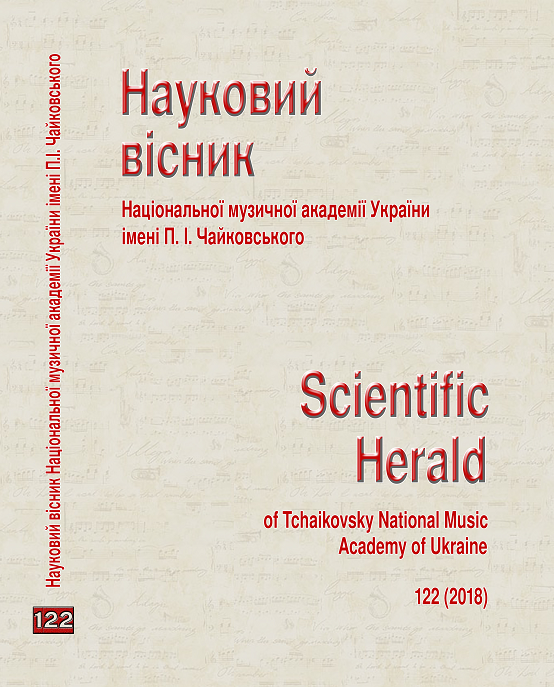An «author’s signs» from style in instrumental music by Hennady Liashenko
DOI:
https://doi.org/10.31318/2522-4190.2018.122.141747Keywords:
instrumental concert, harp, modus, metaphor, canonical rules, neologism, styleAbstract
Relevance of the study. Individual senses from instrumental music by the wellknown Ukrainian composer Hennady Liashenko, are founding with a such difficulties: the contra versions between scientifically and memorial types of analyze in this study are looking like a «translations». Because the topic of stylish, which rule by mental and world viewing specifies of his composer’s meaning, the main attentions must paying to his spirit constants, which are going from genetic base and his individual developing. Really important and actual, this way open new forms in the fields of musicological analyze. Main objective of the study. Studying to composer’s instrumental music and its stylistic specifications (as an example H. Liashenko’s Concert for Harp and strings), we’re seeing they roots in his mental and world viewing constants, widely cultural and psychological preferences.
Methodology As the method of study is complex analyze, which open the deep levels of his creative process. How the study was done. As the still of specifies by Liashenko’s creative meanings, his personal and scientific mentality, spiritual and social states was analyzed as crossing by. In the same analytic way we’re seeing some common connections between his technological disciplines such as «canon».
Results and conclusions. As a result, H. Liashenko constructed his own individual views of form building and about music materiel’s development with the help of some «author signs» We note them as the new text elements (neologism), full of metaphorical senses and which shows some varieties’ potential. In this Concert for Harp and Strings their contain and dramaturgical functions are rich.
Practical significance. The studying of musical piece (and completely, mechanism of composer creation) by this way were opened the deep roots and narratives about individual means in composer’s creative process.
Downloads
References
Ganslik, E. (2012), On The Musically-Beautiful : The Experience of Rethinking of Musical Aesthetics. 2nd ed. Librokom, Moscow, 232 с. [in Russian].
Humen, О. (2009), “Harp History Pages in Ukraine”, Mystectvoznavchi zapysky [ArtStudies Notes], vol. 15, Milenium, Kyiv, pp. 239-244 [in Ukrainian].
Holubovska, I. (2004), Ethnic peculiarities of Language pictures of the world, Lohos, Kyiv, 282 p. [in Ukrainian].
Matviienkiv, O. (2016), “Individually-authored signs of phraseological units in the artistic text of the postmodern age”, available at: http://www.vestnik-philology.mgu.od.ua/archive/v24/part_2/15.pdf (accessed: 21 February 2018). [in Ukrainian].
Stepanov, Yu. (1995), Variable "image of language" in the science of the twentieth century. Language and science of the late twentieth century, Ros. gos. gumanitarnyiy universitet, Moscow, p. 7-34. [in Russian].
Tomashevskiy, B. (1999), Theory of literature. Poetics, Aspekt Press, Moscow, 334 p. [in Russian].
Yuferova, A. (2011), “Some Features of the Cello Solo in the Symphony Orchestra (on Examples of A. Dvorak's Cello Concerto, Variations on the Theme of Rococo P. Tchaikovsky, D. Shostakovich's Second Cello Concert, and S. Prokofiev's Symphony-Concert)”, Kyyivske mpzykoznavstvo [Kyiv musicology], vol. 38, pp. 166-179. [in Ukrainian].
Khrypko, S. (2010), “Values and Constants of Ukrainian Sacred Tradition”, available at: https://www.religion.in.ua/main/analitica/6382-cinnosti-i-konstanti-ukrayinskoyi-sakralnoyitradiciyi.html (accessed: 21 feb 2018). [in Ukrainian].
Downloads
Published
How to Cite
Issue
Section
License
Our journal abides by the CREATIVE COMMONS copyright rights and permissions for open access journals.
Authors, who are published in this journal, agree to the following conditions:
The authors reserve the right to authorship of the work and pass the first publication right of this work to the journal under the terms of a Creative Commons Attribution License, which allows others to freely distribute the published research with the obligatory reference to the authors of the original work and the first publication of the work in this journal.
The authors have the right to conclude separate supplement agreements that relate to non-exclusive work distribution in the form in which it has been published by the journal (for example, to upload the work to the online storage of the journal or publish it as part of a monograph), provided that the reference to the first publication of the work in this journal is included.




